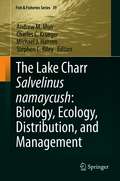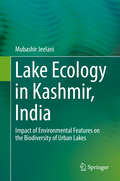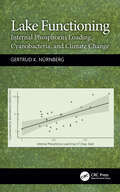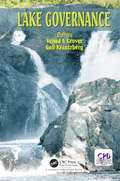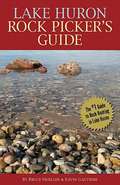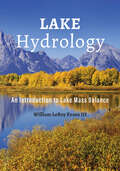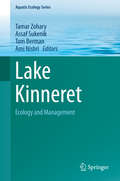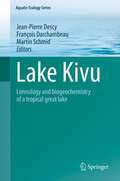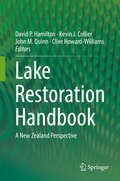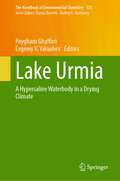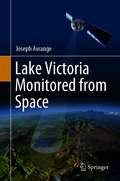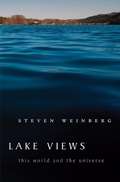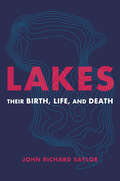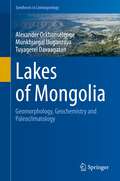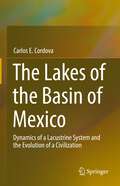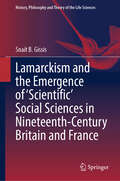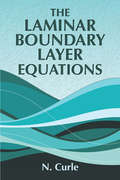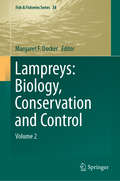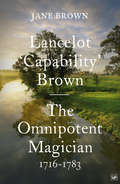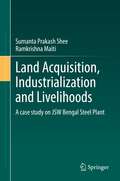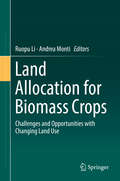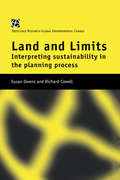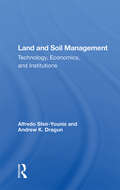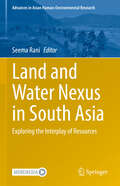- Table View
- List View
The Lake Charr Salvelinus namaycush: Biology, Ecology, Distribution, and Management (Fish & Fisheries Series #39)
by Andrew M. Muir Charles C. Krueger Michael J. Hansen Stephen C. RileyThe lake charr Salvelinus namaycush is a ubiquitous member of cold-water lake ecosystems in previously glaciated regions of northern continental U.S., Alaska, and Canada that often support important commercial, recreational, and subsistence fisheries. The lake charr differs from other charrs by its large size, longevity, iteroparity, top-predator specialization, reduced sexual dimorphism, prevalence of lacustrine spawning, and use of deepwater habitat. The species is remarkably variable in phenotype, physiology, and life history, some of which is reflected in its ecology and genetics, with as many as four morphs or ecotypes co-occurring in a single lake. The lake charr is often the top predator in these systems, but is highly adaptable trophically, and is frequently planktivorous in small lakes. The lake charr by their name highlights their common habitat, lakes both large and small, but often frequents rivers and occasionally moves into the Arctic Ocean. Movement and behaviour of lake charr are motivated by access to cool, well-oxygenated water, foraging opportunities, predator avoidance, and reproduction. Owing to their broad distribution and trophic level, the lake charr serves as a sentinel of anthropogenic change. This volume will provide an up-to-date summary of what is currently known about lake charr from distribution to genetics to physiology to ecology. The book provides a compilation and synthesis of available information on the lake charr, beginning with an updated distribution and a revised treatment of the paleoecology of the species. Understanding of ecological and genetic diversity and movement and behaviour of the species has advanced remarkably since the last major synthesis on the species over 40 years ago. Mid-sections of the book provide detailed accounts of the biology and life history of the species, and later sections are devoted to threats to conservation and fishery management practices used to ensure sustainability. A new standard lake charr-specific terminology is also presented. The book will be a valuable reference text for biologists around the world, ecologists, and fishery managers, and of interest to the angling public.
Lake Ecology in Kashmir, India
by Mubashir JeelaniThis book highlights the anthropogenic pressures on the fresh water bodies and in particular, the Dal and Anchar Lake. As a result of climate change and global warming there is a likelihood that the glaciers which feed these water bodies may be lost. The lakes discussed in this volume can prove a vital source of information on water and biodiversity as well as the environmental features. The detailed examination of phytoplankton and zooplankton in this volume will prove a key factor for future studies in the field of biology and ecology. An in-depth analysis on the physical-chemical properties of the lakes' water is also presented.
Lake Functioning: Internal Phosphorus Loading, Cyanobacteria, and Climate Change
by Gertrud K. NürnbergThis book explores the interconnections of internal phosphorus loading, cyanobacteria, and climate change and their role in determining water quality in freshwater. It goes on to discuss the sometimes elusive process of internal phosphorus loading with its chemical and biological roots. Reviewing recent observations on present and future climate change, the book explores its effects on lake functioning. It concludes with the abatement and prevention of cyanobacteria proliferation, including techniques that deal with internal phosphorus loading. Some key topics covered are: In-depth exploration of internal phosphorus loading and its quantification in global lakes with diverse morphometry, hydrology, geochemistry, and degree of eutrophication. Determination of climate change effects on physical, chemical, and cyanobacteria-related variables in tables based on more than 100 reviewed journal articles. Evidence for the enhancing influences of climate change on internal phosphorus load and cyanobacteria, and of internal load on cyanobacteria. This book will be of interest to limnologists, environmental and engineering professionals, and natural science students. It will also be an interesting read to government agents, lake managers, and others interested in maintaining lake water quality and understanding algal blooms.
Lake Governance: Lessons In Participatory Governance
by Velma I. Grover Gail KrantzbergThe Lake Governance book will focus on comparative analysis of governance structures by examining policy, legal and institutional structures of current transboundary commissions to develop a common framework for good governance of transboundary lakes. Cooperation among nations sharing natural resources is important for sustainable use of the shared resources. Lakes contribute a big part to GDP in most of the countries and in some cases are also responsible for providing fisheries (for food, source of protein and livelihood). Climate change and associated risks and uncertainties add more complexity to the problems. This book will explore current water governance challenges, knowledge gaps and recommend a framework for good lake governance.
Lake Huron Rock Picker's Guide
by Kevin Gauthier Bruce MuellerBruce Mueller is owner of the C&M Rock Shop in Honor, Michigan. He holds a master's degree in geology from the University of Illinois. He is also the author of The Complete Guide to Petoskey Stones. Kevin Gauthier is a business graduate from Michigan State University and has completed courses through Gem Institute of America (GIA). He has spent a lifetime collecting, cutting, and polishing the gems found around Lake Huron. Kevin is co-author with Bruce Mueller of Lake Michigan Rock Picker's Guide and Lake Superior Rock Picker's Guide. He is owner of Korner Gem in Traverse City, Michigan: www. kornergem.com.
Lake Hydrology: An Introduction to Lake Mass Balance
by William LeRoy Evans IIIThe first book dedicated to describing the hydrology of water flow in lake systems, geared for limnologists and students of hydrology.With fresh water becoming a critical issue around the world, lake mass balance—the hydrology or water movement in lakes—is increasingly important to environmental studies and remediation projects. Unfortunately, lake hydrology is often only briefly covered in broader texts on hydrogeology and hydrology or is confined to specialized research papers. Lake Hydrology rigorously describes the hydrology of flow into and out of lake systems. Explaining the physical parameters that influence lake behavior, as well as the mathematics that describes these systems, this in-depth book fills an important niche in the literature of watershed science. This text• describes the physical structure and nature of drainage basins and explains the origin and classification of lakes• explores the hydrology of lake mass balance and storage as it pertains to lake stage, groundwater and lake bottom interaction, hypsometry, lake hydraulics, precipitation, surface flow, evaporation, and transpiration• provides models, practical information, and solutions for lake management or remediation planning utilizing basic data, including stage fluctuation, evapotranspiration, lake-bottom seepage, precipitation, and surface flow • uses examples from real-world long-term studies, including Utah's Great Salt Lake and Florida's Lake Jackson, a karstic lake system• examines the effect of storm events including the temporal and areal distribution of rainfall, and flow paths of water in the catchment from precipitation• includes an introduction to relevant scientific principles, such as dimensional analysis, the properties of water, and the hydrologic cycleUnlike most limnology texts, which emphasize lake ecology and biology, Lake Hydrology is designed to truly elucidate the hydrology of lake systems, especially as it relates to components of the hydrologic cycle. This book will greatly benefit professionals and researchers involved in lake management, remediation, or investigation of lake systems, and can be used as is or integrated within graduate and advanced undergraduate courses in limnology.
Lake Kinneret
by Tamar Zohary Assaf Sukenik Tom Berman Ami NishriThis condensed volume summarizes updated knowledge on the warm-monomictic subtropical Lake Kinneret, including its geophysical setting, the dynamics of physical, chemical and biological processes and the major natural and anthropogenic factors that affect this unique aquatic ecosystem. This work expands on a previous monograph on Lake Kinneret published in 1978 and capitalizes on the outcome of more than 40 years of research and monitoring activities. These were intensively integrated with lake management aimed at sustainable use for supply of drinking water, tourism, recreation and fishery. The book chapters are aimed at the limnological community, aquatic ecologists, managers of aquatic ecosystems and other professionals. It presents the geographic and geological setting, the meteorology and hydrology of the region, continues with various aspects of the pelagic and the littoral systems. Finally, the last section of the book addresses lake management, demonstrating how the accumulated knowledge was applied in order to manage this important source of freshwater. The section on the pelagic system comprises the heart of the book, addressing the major physical processes, external and internal loading, the pelagic communities (from bacteria to fish), physiological processes and the major biogeochemical cycles in the lake.
Lake Kivu
by Jean-Pierre Descy Martin Schmid François DarchambeauIn the heart of Africa, a unique lake attracts the attention of scientists since the beginning of the 20th century. At the foot of the Virunga volcano chain, Lake Kivu harbors a vast amount of dissolved carbon dioxide and methane, making this lake the most dangerous lake on Earth. But the lake furnishes also many goods and services for surrounding populations and may soon become the most important energy supplier in the area. At the beginning of gas exploitation, the time has come for gathering the large amount of scientific information acquired during past and present research on Lake Kivu. The eleven chapters cover many aspects of the physics, geochemistry and biology of the lake, with a particular focus on the unique physical and geochemical features of the water column and on the ecological functioning of the surface waters. The impacts of the introduced fish species and the potential impacts of methane exploitation are also summarized. This multi-disciplinary book may also be used as an introduction to the limnology and biogeochemistry of large tropical lakes, as it covers various aspects of the physics, geochemistry, biology and ecology of the African Great Rift lakes.
Lake Restoration Handbook: A New Zealand Perspective
by David P. Hamilton Kevin J. Collier John M. Quinn Clive Howard-WilliamsLakes across the globe require help. The Lake Restoration Handbook: A New Zealand Perspective addresses this need through a series of chapters that draw on recent advances in modelling and monitoring tools, citizen science and First Peoples’ roles, catchment and lake-focused restoration techniques, and policy implementation. New Zealand lakes, like lakes across the globe, are subject to multiple pressures that have increased in severity and scale as land use has intensified, invasive species have spread and global climate change becomes manifest. This books builds on the popular Lake Managers Handbook (1987), which provided guidance on undertaking investigations into, and understanding lake ecosystems in New Zealand. The Lake Restoration Handbook: A New Zealand Perspective synthesises contemporary issues related to lake restoration and rehabilitation, integrated with social science and cultural viewpoints, and complemented by authoritative topic-area summaries by renowned scientists and practitioners from across the globe. The book examines the progress of lake restoration and the new and emerging tools available to managers for predicting and effecting change. The book will be a valuable resource for natural and social scientists, policy writers, lake managers, and anyone interested in the health of lake ecosystems.
Lake Urmia: A Hypersaline Waterbody in a Drying Climate (The Handbook of Environmental Chemistry #123)
by Peygham Ghaffari Evgeniy V. YakushevThis book provides a holistic review of the environmental status of Lake Urmia in terms of its hydrodynamic, chemical, and ecological properties. Lake Urmia is a shallow landlocked hypersaline water body located in the northwest part of Iran, and it is known as one of the largest continental salt lakes in the world. Divided into 16 chapters, the book gathers leading experts from various scientific disciplines, and it covers past and current characteristics of the lake and traces projections on how the water quantity, quality, chemical, and ecological state of Lake Urmia Basin can develop in the future. The book outcomes are based on the analyses of the data of observations and unique models that were elaborated for the Lake Urmia system development studies. Particular attention is given to the basin drought in response to anthropogenic drivers and environmental pressures such as climate variability and climate change and their impact on the aquatic environment. The impact of water conveyance on Lake Urmia to improve the physical, chemical, and biological natural state is also discussed in this book, where an intensive and challenging observation plan in this harsh environment is combined with uniquely coupled and adopted hydrodynamical-biogeochemical models. Given its scope, the book offers an invaluable source of information for researchers, students, and environmental managers interested in the Lake Urmia environment.
Lake Victoria Monitored from Space
by Joseph AwangeThis book employs a suite of remotely sensed products and advanced technologies to provide the first comprehensive space-based sensing of Lake Victoria, the world’s second largest freshwater lake that supports a livelihood of more than 42 million people, modulates regional climate, but faces myriads of challenges. Proper understanding of the lake and changes in its physical dynamics (e.g., water level, shorelines and areal dynamics) resulting from the impacts of climate variation and climate change as well as anthropogenic (e.g., hydropower and irrigation) is important for its management as well as for strategic development before, during and after climate extremes (e.g., floods and droughts) in order to inform policy formulations, planning and mitigation measures. Owing to its sheer size, and lack of research resources commitment by regional governments that hamper its observations, however, it is a daunting task to undertake studies on Lake Victoria relying solely on in-situ “boots on the ground” measurements, which are sparse, missing in most cases, inconsistent or restricted by governmental red tapes. To unlock the potentials of Lake Victoria, this book argues for the removal of obsolete Nile treaties signed between Britain, Egypt and Sudan in the 1920s and 1950s, which prohibits its utilization by the upstream countries. The book is useful to those in water resources management and policy formulations, hydrologists, environmentalists, engineers and researchers.In a unique cross-disciplinary approach, the Book articulates the various climatic impacts and explanations from natural and anthropogenic origins, which affected Lake Victoria and its vicinity, including the drastic increase and depletion of water level in the Lake and dams, floods and droughts, water quality/security, crop health, food security, and economic implications. With no exception as in his many publications, Joseph L. Awange used data analysis methodologies including filtering, adjustment theory, and robust statistics, to quantify the hydrologic and other parameters, and their estimated uncertainties. The Book is recommended for readers from a diverse disciplines, including physical and social sciences, policy, law, engineering, and disaster management. Professor C.K. Shum, Ohio State University.
Lake Views: This World and the Universe
by Steven WeinbergA Physics World Top Ten Book of 2010Steven Weinberg, considered by many to be the preeminent theoretical physicist alive today, continues the wide-ranging reflections that have also earned him a reputation as, in the words of New York Times reporter James Glanz, a powerful writer of prose that can illuminate-and sting.
Lakes: Their Birth, Life, and Death
by John Richard Saylor&“Lakes is my favorite kind of natural history: meticulously researched, timely, comprehensive, and written with imagination and verve.&”—Jerry Dennis, author of The Living Great Lakes Lakes might be the most misunderstood bodies of water on earth. And while they may seem commonplace, without lakes our world would never be the same. In this revealing look at these lifegiving treasures, John Richard Saylor shows us just how deep our connection to still waters run. Lakes is an illuminating tour through the most fascinating lakes around the world. Whether it&’s Lake Vostok, located more than two miles beneath the surface of Antarctica, whose water was last exposed to the atmosphere perhaps a million years ago; Lake Baikal in southern Siberia, the world&’s deepest and oldest lake formed by a rift in the earth&’s crust; or Lake Nyos, the so-called Killer Lake that exploded in 1986, resulting in hundreds of deaths, Saylor reveals to us the wonder that exists in lakes found throughout the world. Along the way we learn all the many forms that lakes take—how they come to be and how they feed and support ecosystems—and what happens when lakes vanish.
Lakes of Mongolia: Geomorphology, Geochemistry and Paleoclimatology (Syntheses in Limnogeology)
by Alexander Orkhonselenge Munkhjargal Uuganzaya Tuyagerel DavaagatanThis book provides an overview of lakes in Mongolia from scientific, economic and scenic points of view, presenting lake area changes, their sedimentological and geochemical characteristics, valuable economic and geoheritage resources and paleoclimate change reconstruction. The book emphasizes internationally well-known lakes of Mongolia, but it also describes far less popular lakes which have remained unrecognized for scientific importance. The book offers modern, qualitative, process-oriented approaches and quantitative analytic results-based implications to understand the geomorphological, sedimentological and geochemical evolution of lake basins in Mongolia, and past and present climate changes in Mongolia and Eurasia. Insights into the interpretation of data obtained from the lake basins in the fields of geomorphology, sedimentology, geochemistry, geochronology and paleoclimatology are developed from theoretical principles, empirical observations, correlative illustrations, analytic measurements and conscious hypotheses. Based on the application of a combined compilation of recent Landsat 8 images of the lakes and topographic maps of them in 1970, this book presents enriched results and implications derived from remote sensing together with field measurements and laboratory analyses. This data compilation belongs to a research team at the Laboratory of Geochemistry and Geomorphology (LGG), National University of Mongolia (NUM).
The Lakes of the Basin of Mexico: Dynamics of a Lacustrine System and the Evolution of a Civilization
by Carlos E. CordovaThis book is a review of research on the prehistoric and historic evolution of the Basin of Mexico’s lacustrine systems. Based on this review, the book presents a model of long and short-term natural lacustrine dynamics as the basis for understanding the processes of human adaptation and transformation of the aquatic ecosystems of the Basin of Mexico. Although only remains of the former lakes exist, the book stresses the importance of the knowledge of the former natural and cultural history of the lakes. In this sense, the book addresses the misconceptions and misinterpretations of the lakes that still exist in the literature and the media and that do not reflect the real nature of the lakes in the past. Therefore, the book attempts to not only feed into the local knowledge of the lakes, but also contribute to the worldwide knowledge of lacustrine dynamics and human populations that lived in and around them. The book should be of interest to geographers, geologists, archaeologists, natural historians and environmental scientists, civil engineers, city planners and those involved in the management of natural resources.
L’Alzheimer: une maladie redoutable I
by Juan Moises de la Serna Bakrim NouryIssu d’une trilogie amplement consacrée à la maladie Alzheimer, ce livre a été conçu à la base de questionnements utiles. D’emblée un mot sur ses mérites pédagogiques : le livre adopte une démarche rationnelle simplifiée qui permet à tous les lecteurs concernés de comprendre le phénomène qui les accable, partant ontologiquement de la définition très fine en passant par la causalité pour enfin aboutir aux conséquences variées. En outre, son intelligence se traduit par une articulation des questionnements ‘’populaires’’ aux grands questionnements de la recherche contemporaine sur l’Alzheimer. Pour l’avoir lu et traduit, je peux affirmer que cet équilibre est réussi. Le livre est aussi utile et fiable quand il s’agit de diversifier les références aux solutions thérapeutiques ou celles concernant les résultats de l’état de l’art actuel en matière d’Alzheimer : dans ce sens bien précis, les données sont exposées avec un sens aigu de la critique qui permet non seulement de comprendre ‘’ce qui se fait’’ aux quatre coins du monde mais aussi de pouvoir adopter une vision claire sur ‘’ce qui peut être concrètement fait’’ afin de retarder voire même de guérir la dégénérescence des fonctions cognitives de la mémoire. D’autres apports seront certainement un atout pour les lecteurs concernés ou curieux: la distinction d’Alzheimer des autres démences, où il propose même une forme de diagnostic enrichi, une nouvelle méthode de prévention/d’anticipation publique et familiale très utile pour les proches par exemple. L’accent mis sur l’inefficacité pharmacologique est une autre voie de vulgarisation où les lecteurs sauront comment se situer face aux traitements médicamenteux actuellement disponibles. Enfin, trois pistes sont suggérées où l’argumentation du livre culmine avec des propositions claires : la piste génétique, la piste biologique et la piste psycholo
Lamarckism and the Emergence of 'Scientific' Social Sciences in Nineteenth-Century Britain and France (History, Philosophy and Theory of the Life Sciences #36)
by Snait B. GissisThe book presents an original synthesizing framework on the relations between ‘the biological’ and ‘the social’. Within these relations, the late nineteenth-century emergence of social sciences aspiring to be constituted as autonomous, as 'scientific' disciplines, is described, analyzed and explained. Through this framework, the author points to conceptual and constructive commonalities conjoining significant founding figures – Lamarck, Spencer, Hughlings Jackson, Ribot, Durkheim, Freud – who were not grouped nor analyzed in this manner before. Thus, the book offers a rather unique synthesis of the interactions of the social, the mental, and the evolutionary biological – Spencerian Lamarckism and/or Neo-Lamarckism – crystallizing into novel fields. It adds substantially to the understanding of the complexities of evolutionary debates during the last quarter of the nineteenth century. It will attract the attention of a wide spectrum of specialists, academics, and postgraduates in European history of the nineteenth century, history and philosophy of science, and history of biology and of the social sciences, including psychology.
The Laminar Boundary Layer Equations (Dover Books on Physics)
by N. CurleA thorough introduction to the study of boundary layer problems in physics and fluid mechanics, this treatment assumes some knowledge of classical inviscid fluid dynamics. The ordered and logical presentation is accessible to undergraduates, and professionals will benefit from the careful expositions of the limitations and accuracy of various methods.An extensive introduction explains the boundary-layer concept and demonstrates its simplification of equations of viscous flow. Successive chapters address various aspects of solution in incompressible flow, starting with analytic solutions of the velocity field and advancing to discussions of high-accuracy numerical solutions, practical methods of calculation, and an analysis of factors that might govern the choice of a method. Several chapters on the compressible laminar boundary layer include examinations of pressure gradient and heat transfer, followed by a brief exploration of some aspects of the problem of the interaction between shock waves and laminar boundary layers. Complete references and a helpful Index conclude the text.
Lampreys: Volume 2 (Fish & Fisheries Series #38)
by Margaret F. DockerThis book, published in two volumes, provides the most comprehensive review of lamprey biology since Hardisty and Potter’s “The Biology of Lampreys” published more than 30 years ago. This second volume offers a synthesis of topics related to the lamprey gonad (e.g., lamprey sex ratios, sex determination and sex differentiation, sexual maturation, and sex steroids), the artifical propagation of lampreys, post-metamorphic feeding and the evolution of alternative feeding and migratory types, the history and status of sea lamprey control in the Laurentian Great Lakes and Lake Champlain, and an overview of contributions of lamprey developmental studies for understanding vertebrate evolution.
Lancelot 'Capability' Brown, 1716-1783: The Omnipotent Magician
by Jane BrownLancelot Brown changed the face of eighteenth-century England, designing country estates and mansions, moving hills and making flowing lakes and serpentine rivers, a magical world of green. This English landscape style spread across Europe and the world. At home, it proved so pleasing that Brown's influence spread into the lowland landscape at large, and into landscape painting. He stands behind our vision, and fantasy, of rural England. In this vivid, lively biography, based on detailed research, Jane Brown paints an unforgettable picture of the man, his work, his happy domestic life, and his crowded world. She follows the life of the jovial yet elusive Mr Brown, from his childhood and apprenticeship in rural Northumberland, through his formative years at Stowe, the most famous garden of the day. His innovative ideas, and his affable and generous nature, led to a meteoric rise to a Royal Appointment in 1764 and his clients and friends ranged from statesmen like the elder Pitt to artists and actors like David Garrick. Riding constantly across England, Brown never ceased working until he collapsed and died in February 1783 after visiting one of his oldest clients. He was a practical man but also a visionary, always willing to try something new. As this beautifully illustrated biography shows, Brown filled England with enchantment - follies, cascades, lakes, bridges, ornaments, monuments, meadows and woods - creating views that still delight us today.
Land Acquisition, Industrialization and Livelihoods: A case study on JSW Bengal Steel Plant
by Ramkrishna Maiti Sumanta Prakash SheeThis book provides an assessment of the impacts of human intervention on the natural environment and peoples' livelihoods through land-use conversion due to industrialization. Problems of land acquisition and the execution thereof have varying consequences that depend on the specific geographical as well as socio-political contexts in which they occur. This book covers a specific study of JSW Bengal Steel Ltd., which in 2014 planned to set up a 10.0 million ton per year integrated steel plant at the upper catchment of Sundra basin, the tributary of the Shilabati that ultimately pours to the river Rupnarayan, located at Salboni Block of Paschim Medinipur, West Bengal, India. The project was ultimately put on hold, but caused many lingering environmental and socioeconomic problems due to the acquisition of formerly productive lands. The book examines this case to generate a database on the different aspects of land acquisition and its negative impacts on the geomorphology and hydrological of non-timber forest products, agricultural impacts resulting in livelihood changes, policy dimensions of land acquisition, and the impacts of delays in project implementation through a comparative analysis between projects-affected areas and non-project areas. The book will appeal to environmental managers and industry workers, as well as students and researchers in environmental economics, anthropology, and human geography.
Land Allocation for Biomass Crops: Challenges and Opportunities with Changing Land Use
by Andrea Monti Ruopu LiThis edited volume establishes a forum for international experts to explore cutting-edge questions associated with the land use and biomass production. Topics include ‘do we have enough land, either primary or marginal, to accommodate future production of biomass?’, ‘how are farming decisions made in response to biomass incentives?’, ‘is the current bio-mass production socially, economically and environmentally sustainable?’, and ‘what are the main constraints currently limiting biofuel deployment?’ The expansion of biomass production is often at the cost of reduced land availability for food production and losses of areas with ecological functions such as forests and wetlands. This process often involves complex interplay of physical dynamics and human systems that are driven by numerous geographic and socio-economic factors at different scales. Thus, the state-of-the-art research on the land use issues surrounding the biomass production and its environmental impacts is important for informed land management decision making. This book will be of great use to researchers in land use management and biomass-based renewable energy, as well as practitioners.
Land and Limits: Interpreting Sustainability in the Planning Process (Rtpi Library Ser.)
by Richard Cowell Susan OwensIn a new and critical analysis, this book explores the impact of an influential idea - sustainable development - on the institutions and practices governing use of land. It examines the paradox that in spite of increasing attention to sustainability, land use conflict is as ubiquitous and intense as ever.
Land And Soil Management: Technology, Economics, And Institutions
by Alfredo Sfeir-YounisSoil erosion has become a problem of crisis proportions in developing countries around the globe, and better approaches to land management are desperately needed. This book provides analytical frameworks to guide the creation and appraisal of soil erosion control programs. The authors discuss a broad range of important issues involved in designing and implementing more effective soil conservation programs. The book begins with a discussion of the physical and economic dimensions of soil erosion and an estimation of the extent of the problem. It then explains how to improve the evaluation of soil conservation programs by integrating scientific knowledge with economic methods and procedures. A series of practical illustrations graphically demonstrates the application of the concepts derived from the theory. The most important organizational, institutional, technical, and macroeconomic aspects of soil and land management appraisal are outlined, and the major elements of project or program design are also pinpointed and illustrated. Finally, the book suggests areas most in need of future research.
Land and Water Nexus in South Asia: Exploring the Interplay of Resources (Advances in Asian Human-Environmental Research)
by Seema RaniThis book aims to unravel the intricate relationship between land and water resources and delve into their interdependencies, synergies, and challenges. As the world grapples with pressing issues such as water scarcity, land degradation, and climate change, understanding the complex dynamics and interplay between these two critical resources has become more crucial than ever. This comprehensive volume brings together multidisciplinary perspectives from leading experts in the field, offering an integrated approach to studying the land-water nexus. The book provides readers with a clear understanding of how land and water interact and delves into key topics such as land use change and its impacts on water resources, water management in agricultural landscapes, land-water interactions in aquatic ecosystems, urbanization and water resource management, and climate change's influence on the land-water nexus. Moreover, the book investigates integrated governance frameworks, policy considerations, and sustainable development approaches that are essential for effective land and water resource management. It also sheds light on future perspectives and research frontiers, envisioning innovative solutions to address emerging challenges in this field. By synthesizing current knowledge, showcasing case studies, and presenting cutting-edge research, this book provides a valuable resource for researchers, policymakers, and professionals working in water resource management, environmental science, agriculture, urban planning, and sustainable development. The book's holistic approach encourages readers to envision sustainable pathways that balance the needs of both land and water, fostering a resilient and harmonious future for our planet.
